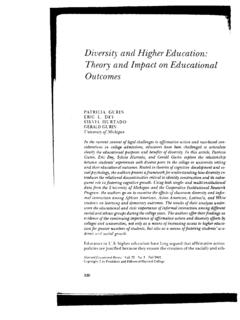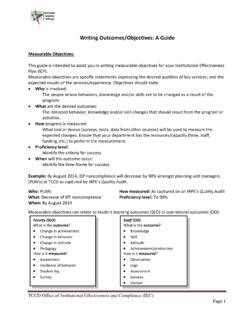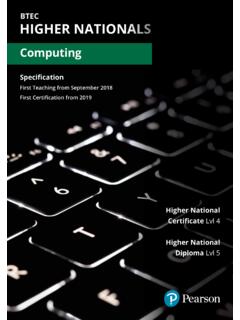Transcription of 2020 HIGHER EDUCATION FACTS AND FIGURES
1 UNIVERSITIES AUSTRALIA 2020 higher education facts and figures OCTOBER 2020 This work is licensed under a Creative Commons Attribution International Licence. Further inquiries should be made to the Chief Executive: GPO Box 1142 Canberra ACT 2601 Ph: +61 (0)2 6285 8100 Fax: +61 (0)2 6285 8101 Email: ABN 53 008 502 930 UNIVERSITIES AUSTRALIA | HIGHER EDUCATION FACTS AND FIGURES 3 FOREWORD 2020 is the year that FACTS , evidence and data became more critical than ever before. As the COVID-19 pandemic unfolded, Australia turned to university experts, research and facilities to educate and inform. Before that, universities helped with our understanding and response to the summertime bushfire crisis. The elevation of FACTS and expertise was to the country s great benefit. Whether in periods of relative calm or crisis, Australian universities provide a standing army of experts that underpin community discussion with knowledge and evidence.
2 To help with an informed discussion about Australian HIGHER EDUCATION , the peak body for Australia s universities produces a regular snapshot of the sector s FACTS and FIGURES . In 2020 higher education facts and figures you will find the most recent key FACTS and FIGURES about funding, students, staff, world-class research, international rankings performance and much more. This update tells a clear story: universities remain a cornerstone of Australia s economic success. In 2018, universities contributed $41 billion to the Australian economy and supported a total of 259,100 full-time jobs. Notably, 325,171 students completed their degrees at Australia s 39 universities. In the future, Australia will need even more new ideas, new skills and new jobs to power the economic and social recovery. Universities will drive the nation s recovery through their research and innovation, and through the skilled graduates they supply to the labour market. While this year s update does not yet reflect some of the profound changes brought about by the COVID-19 pandemic or the newly created 30,000 university places, we do see the impact of the December 2017 cap on domestic undergraduate places.
3 We hope you find this publication an informative contribution on the value of Australia s university sector: to our students, staff, and to the nation. Professor Deborah Terry AO Chair, Universities Australia Ms Catriona Jackson Chief Executive, Universities Australia Note: data in this report was current as at 9 September 2020 UNIVERSITIES AUSTRALIA | HIGHER EDUCATION FACTS AND FIGURES 4 CONTENTS List of FIGURES .. 6 List of tables .. 11 1 Funding and university finances .. 12 Australian Government funding .. 12 Australian Government HIGHER EDUCATION outlays .. 12 Funding per Commonwealth supported place .. 14 Public vs private contribution for commonwealth supported places 15 Other funding to support teaching and learning .. 17 International comparisons .. 21 HIGHER EDUCATION Loan Program (HELP) .. 23 University finances .. 25 Revenue by source .. 25 Expenditure by category .. 26 Universities financial position.
4 27 2 Students .. 29 Domestic students .. 30 Trends in domestic enrolments .. 30 Student profiles .. 30 International students .. 36 Trends in international student enrolments .. 36 Student profiles .. 39 Contribution to the Australian economy .. 42 Student load .. 44 Trends in student load by liability status .. 44 Composition of domestic student places .. 45 Trends in Commonwealth supported places .. 46 Commonwealth supported places and population growth .. 48 Enrolments in courses leading to professional registration .. 50 Work-integrated learning .. 52 Student outcomes and employment .. 53 Award course completions .. 53 Attrition and completion rates .. 54 Graduate employment .. 56 Graduate salaries .. 59 UNIVERSITIES AUSTRALIA | HIGHER EDUCATION FACTS AND FIGURES 5 Satisfaction .. 61 Educational attainment .. 62 3 Science, research and innovation .. 66 Australian Government support for science, research and innovation.
5 66 Sources of university research income .. 67 Changing composition of Australian Government funding for university 69 Government funding to support research training .. 70 Australia s gross expenditure on research and development .. 72 International comparisons .. 73 University spending on research and development .. 75 Research outcomes .. 78 HIGHER degree by research completions .. 78 Research excellence .. 78 International research collaboration .. 81 University-industry collaboration .. 82 4 International rankings .. 84 5 University workforce .. 86 6 Indigenous students and staff .. 89 Indigenous student enrolments .. 89 Field of EDUCATION .. 90 Course 91 Undergraduate applications .. 91 Indigenous student outcomes .. 94 Award course completions .. 94 Completion rates .. 95 Labour market outcomes .. 96 Indigenous workforce .. 98 Academic vs non-academic .. 98 Staff characteristics .. 100 UNIVERSITIES AUSTRALIA | HIGHER EDUCATION FACTS AND FIGURES 6 LIST OF FIGURES Figure 1: Australian Government HIGHER EDUCATION spending, in 2018 dollars.
6 13 Figure 2: Australian Government HIGHER EDUCATION spending as a percentage of GDP .. 13 Figure 3: Total funding per Commonwealth supported place, in 2018 dollars .. 15 Figure 4: Other government funding to support teaching and learning, by purpose, 2018 dollars 18 Figure 5: HEPPP funding actual and budget cuts .. 19 Figure 6: Funding for Disability Support Program total and per student in 2018 dollars .. 20 Figure 7: Public investment in tertiary EDUCATION institutions as a percentage of GDP, 2017 .. 21 Figure 8: Private investment in tertiary EDUCATION institutions as a percentage of GDP, 2017 .. 22 Figure 9: Estimated average annual tuition fees charged by public institutions for domestic students at Bachelor degree or equivalent, 2017 2018, in US dollars .. 23 Figure 10: Amount of new HELP lending by programs, in nominal dollars .. 25 Figure 11: Sources of university revenue, in 2018 dollars .. 26 Figure 12: Categories of university expenditure, in 2018 dollars.
7 27 Figure 13: University net operating results, 2010 to 2018, in 2018 dollars .. 28 Figure 14: Proportion of universities by size of operating margins, 2010 to 2018 .. 28 Figure 15: Overall university enrolments, 2001 to 2018 .. 29 Figure 16: Overall enrolments, by broad disciplines, 2018 .. 29 Figure 17: Annual growth in domestic enrolments, by course levels, 2005 to 30 Figure 18: Domestic students, by course level and type of attendance, 2018 .. 31 Figure 19: Share of domestic students studying full-time, 2005 to 2018 .. 31 Figure 20: Share of commencing domestic undergraduate students, by age cohort .. 32 Figure 21: Annual growth in commencing domestic undergraduate student enrolments, by age cohort .. 32 Figure 22: Basis of admissions for commencing domestic Bachelor degree 33 Figure 23: Domestic undergraduate and postgraduate enrolments, by broad field of EDUCATION , 2018 .. 34 Figure 24: Growth in domestic undergraduate enrolments, by broad field of EDUCATION , between 2008 and 2018.
8 34 Figure 25: Growth in domestic postgraduate enrolments, by broad field of EDUCATION , between 2008 and 2018 .. 35 UNIVERSITIES AUSTRALIA | HIGHER EDUCATION FACTS AND FIGURES 7 Figure 26: Number of domestic undergraduate student enrolments, 2008 and 2018 .. 35 Figure 27: International student enrolments, 2001 to 2018 .. 36 Figure 28: International student enrolments, by course levels .. 37 Figure 29: International HIGHER EDUCATION students in Australia, by country or region of origin, 2018 .. 38 Figure 30: Distribution of international students in tertiary EDUCATION , by country of destination, 2017 .. 38 Figure 31: Share of students by gender, domestic vs international students, 2008 and 2018 .. 39 Figure 32: Share of students by course level, domestic vs international students, 2008 and 2018 .. 40 Figure 33: Share of students by broad field of EDUCATION , domestic vs international students, 2018 .. 41 Figure 34: Growth in international student enrolments by broad field of EDUCATION , between 2008 and 2018.
9 42 Figure 35: Value of EDUCATION -related personal travel exports, in nominal dollars .. 43 Figure 36: Type of international student expenditure, by educational sector, 2019 .. 43 Figure 37: EFTSL student places by liability status, 2001 to 2018 .. 44 Figure 38: Annual growth in commencing EFTSL, by liability status, 2005 and 2018 .. 45 Figure 39: Composition of domestic student places, 2018 .. 45 Figure 40: Commonwealth supported places, 2001 to 2018 .. 46 Figure 41: Annual growth in Commonwealth supported places, 2001 to 2018 .. 47 Figure 42: Commonwealth supported places, by course level, 2001 to 2018 .. 47 Figure 43: Commonwealth supported places per 10,000 population aged 15 24 years old .. 48 Figure 44: Actual Commonwealth supported places compared to the 15 24 year old population 49 Figure 45: Estimated annual increase in additional Commonwealth supported places to align with population growth .. 49 Figure 46: Enrolments in courses for initial teacher training.
10 50 Figure 47: Enrolments in courses for initial registration as nurses .. 50 Figure 48: Enrolments in courses leading to provisional registration as a medical practitioner .. 51 Figure 49: Enrolments in courses leading to provisional registration as a dental practitioner .. 51 Figure 50: Work-integrated learning participation rates, by broad field of EDUCATION , unique headcount, per cent .. 52 UNIVERSITIES AUSTRALIA | HIGHER EDUCATION FACTS AND FIGURES 8 Figure 51: Work integrated learning participation rates, by student characteristic, per cent .. 53 Figure 52: Number of award completions, by course level .. 53 Figure 53: Attrition rate for domestic commencing Bachelor degree students .. 54 Figure 54: Completion rates nine, six and four years of commencing domestic Bachelor degree students .. 55 Figure 55: Graduate full-time employment rate four months after completing their degree by course levels, per cent .. 57 Figure 56: Short- and medium-term full-time employment rate for 2007 to 2017 graduates undergraduate degree, per cent.








